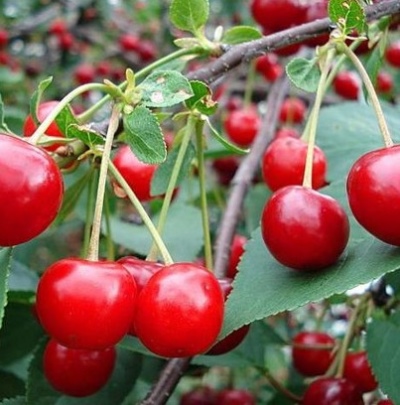
- Authors: Sverdlovsk Horticultural Selection Station
- Appeared when crossing: Ideal x Michurin cultivars
- Year of approval: 1959
- Barrel type: bush
- Growth type: undersized
- Crown: broadly rounded
- Escapes: green, turns purple-brown with age
- Leaves: obovate, smooth plate with serrated edges and sharp end
- Flowering and fruiting type: mixed
- Fruit size: average
Ural Ruby is an old cherry variety, but it is still quite in demand today, especially in the north of Russia. The culture belongs to technical types, the workpieces from it are the most delicious and aromatic.
Breeding history
The culture was obtained on the basis of the Sverdlovsk selection station of gardening back in 1954. This is a hybrid of the steppe cherry, which was created by crossing the cultivars of Michurin developments with the Ideal cherry. Breeders Zhukov and Gvozdyukova worked on its creation. Their task was to develop a crop for cultivation in the cold weather conditions of Siberia and the Urals.
Beginning in 1955, the selection result was sent to the State Grade Trials, and 4 years later (1959) the State Register Commission allowed the culture to be used throughout the country. Today, the Ural ruby is widely used for breeding work to create the newest varieties, being a carrier of good productivity indicators, short stature, frost and drought resistance.
Description of the variety
Like all steppe types of cherries, the Ural Ruby Cherry develops not like a tree, but like a shrub, moreover, weakly growing, reaching a height of one and a half meters. It has a wide-round crown, it has spreading, drooping branches. The green young growth over time becomes brownish-purple and becomes bare.
The leaves are obovate, pointed, with jagged edges. Leaves are two-colored - the upper surface is dark green, below it is light. Flowers and subsequently fruits are formed either on shoots 1 year old, or on bouquet branches.
Fruit characteristics
The fruits of the steppe cherry are small, their weight is usually 3.5 grams. The berries are round, the skin is dark red, smooth. Ural ruby - a typical griot (or morel), juicy cherry pulp along with juice is also colored red. The not very long stalk holds the berry firmly, they will not crumble, being fully ripe. The stone separates well from the fruit.
Taste qualities
Cherries are sweet and sour, the taste is satisfactory. Some consider it a sugary sweet dessert. Therefore, the variety is classified as technical, that is, due to similar characteristics, it is not very suitable for fresh consumption. Basically, the fruits are processed into compotes, juices, preserves, jams, used in cooking. In principle, you can, of course, eat it, but other varieties can be tastier when consumed fresh. In terms of the processed products and treats obtained, they are on top and even outperform products from other cherry varieties.
Ripening and fruiting
The variety in question has a late ripening period, but it is simultaneous. The culture bears fruit every year stably since the 3rd year.

Yield
The yield of Ural Ruby cherries is considered high. On average, 6-10 kg of cherries are harvested from one bush, and in commercial production - 60-90 c / ha. The berries ripen together.
Growing regions
According to the State Register, the crop is intended for cultivation in all regions. However, it grows best in regions with a cool climate, such as Volgo-Vyatka, Ural, West Siberian. In the southern open spaces it manifests itself worse.
Self-fertility and the need for pollinators
The culture is self-fertile. For its fruiting, cross-pollination with other cherries is necessary, which bloom simultaneously with it and grow no further than 40 meters. Such varieties as Tamaris, Nord Star, Mechta of the Trans-Urals, Izobilnaya are well suited for this. The very same Ural ruby plant is often planted as an excellent pollinator of most late cherry varieties.
Landing
The optimal time for planting the culture in question in the regions of northern latitudes will be the beginning of spring, the period before bud break. In the fall, planting is also possible, only the bush may not have time to take root until the first frost.
The best placement of steppe cherry is a hill, well-lit by the sun, a slope facing west, north-west or south-west. On a flat territory, the culture will grow worse, in a hole or lowland it may even die or it will often get sick, and a good harvest may not be expected.
In this case, it is better to choose a loose, fertile, neutral soil, for example, loamy. It is better to avoid groundwater or it should run deeper than 2 meters from the surface of the earth.


Growing and care
Immediately after planting, the plant needs regular watering. In the future, the bush is watered only in drought. A large amount of moisture is needed by the culture at the very beginning of the growing season, as well as during the formation of ovaries. Watering should be stopped about two to three weeks before the fruits ripen. If the autumn is dry, you need water-charging irrigation.
Ural ruby requires sanitary as well as formative pruning. It is necessary to shorten the branches that grow upward. In an adult plant, you will need to gradually remove all old skeletal branches.


Disease and pest resistance
The variety is moderately susceptible to such ailments as coccomycosis, fungal diseases. May be affected by cherry aphids and sawfly, but rarely. Preventive treatment should not be neglected.
Requirements for soil and climatic conditions
Cherry was specially created for cultivation in the climate of Siberia. Its frost resistance is high (up to -35C). Trees winter well under the snow, and are also resistant to spring frosts.
































































